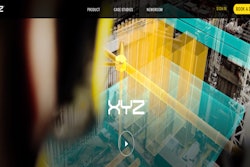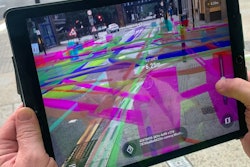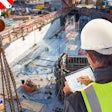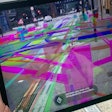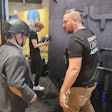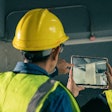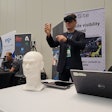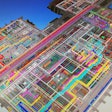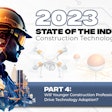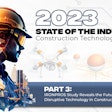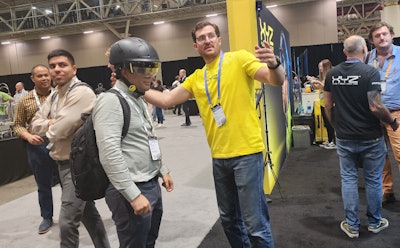
The most precise and advanced technologies tend to come to mission-critical construction sectors first, and this is certainly the case with XYZ Reality’s augmented reality solution.
Founded in 2017, the London-based company is on a sales push in North America for its Atom product. The solution displays a building information model (BIM) superimposed on a project in progress, enabling real-time spotting of disparities against design. Other methods for spotting discrepancies from plan introduce lag time between when a reality capture through photogrammetry or LIDAR take place and when the data is viewed in context. Looking through augmented reality display of the purpose-built Atom construction headset, a user can immediately identify discrepancies during system installation or construction, enabling a course correction in real time.
XYZ Reality is not the first vendor to move in the direction. Daqri in 2015 came to market with its Smart Helmet, which combined a Qualcomm Snapdragon processor with 360 degree cameras around, an industrial inertial measurement unit and a high-definition depth sensor. The goal was to build 3D models of project sites for quality control and reporting. Daqri folded in 2019, and a contemporaneous partnership between Trimble and Microsoft with its HoloLens product may have hit a snag with the January, 2023 layoffs and apparent shutdown of HoloLens operations not associated with a wide-field-of-vision offering that is part of a $21.88 million contract.
With Trimble the Trimble XR10 and Trimble Connect for Hololens, Trimble extends its Trimble Field Link to harness augmented reality for on-site personnel, even sharing what on-site personnel see with others who may be remote, in real time. Microsoft has since announced the Hololens 2 headset will be upgradeable to Windows 11. This not only suggests the Hololens platform will be safe despite force reductions, and also makes the Microsoft WebView2 Runtime developer's tool accessible to Hololens. This means developers can integrate web content in apps running on Hololens. This could create interesting workflow possibilities as users could be able to interact with web services from other construction software applications.
Construction Augmented Reality
On an August, 2023 IRONPROS discovery call, XYZ Reality Mission Critical Director Waleed Zafar described how the company was currently driving the millimeter-accuracy tech to market by delivering not just the application and headsets as raw gear, but also a crew of operators to use the tech rather than customers’ own crews.
“As of today, when we offer a solution, it is a full end-to-end service,” Zafar said. “We provide the headsets and technology, but also the boots on the ground so our customers get people who are using this tech every day. Oftentimes, people resources at our customer organizations are 130% committed. If they are adding new technology, there is no capacity to master it. Doing it this way is driving stronger adoption and maximum value add right off the bat. It ensures customer success that scales across the project.”
An Opportunity for Survey and Engineering Firms
This delivery method will change in the coming months as XYZ Reality has started to build out a network of partners who will act as value added resellers (VARs) for the solution. An early example, according to Zafar, is ECC Group, which delivers services ranging from engineering to construction management and quality control to major projects in the United Kingdom and Europe.
“We have two more of these partnerships pending,” Zafar said. “We are absolutely looking at cannibalizing our current business as these partners deploy our solutions … The ultimate north star for us is for builders to build from holograms. We enable construction teams from around the world to build it right the first time, and this is one of a series of steps to get to that ultimate vision.”
According to Zafar, engineering and aligned businesses that may currently rely on tools like laser scanning to ensure project in the field for their owner and general contractor customers. The XYZ Reality offering could help these companies increase revenue and deliver transformational technology to their client base.
Expedited Construction Quality Control
Using XYZ Reality, a foreman, inspector or other worker on-site can spot discrepancies against the BIM in real time. The technology is also used to track progress against the plan.
“As of today, in the best of scenarios, someone goes out with an iPad, sees drawing versus what is in place and, winds up saying ‘we are about 20 percent complete,’” Zafar said. “How do we make that data completely objective? We take the subjectivity out of the equation.”
Photogrammetry and LIDAR technologies from construction data capture vendors like Avvir, Buildots and Openspace also address production tracking, but only after the fact.
“Once someone goes out with one of these solutions to do captures by walking through a project flying a drone, or using a fixed position camera, there is still a fairly tedious task to collate all of the information, often putting it into Excel,” Zafar said. “What percentage of completion are we for each trade? We can make that determination in real time.”
Between when site data is captured and when it is used to support project decisions, this disconnect can cause delays of six to eight weeks, according to Zafar, leading to a disconnect between facts on the ground and dashboards and other devices used to support application for payment and project management.
Tech Stack
“We take the construction models from a particular project, take the program or project schedule, and link the two together,” Zafar said. “How we do that is through our XYZ Model Viewer—which is software we actually developed in-house. We link the schedule activity to the relevant elements in the models. By linking them together, we have created a 4D model.”
This 4D model is then linked in the XYZ Reality cloud environment to the headset. A headset-wearing user then can see reality augmented by a BIM model with millimeter accuracy and the ability to spot discrepancies and schedule risks in real time. This means that if work is not installed within acceptable tolerances, it can be resolved immediately, reducing rework. As work is put in place, it is marked as conforming or not conforming to the model, with a record of what is delivered porting to an as-built. Data moves from the headset back to the cloud as the headset comes within range of wifi for rapid population of dashboards used in the back office.
In construction environments of any complexity, the model and schedule will change, either through change orders from the field or design adjustments from engineers, architects or owners. Constrained availability of equipment, people, mechanical systems or inventory items may push a project out. In many situations, this results in revision control issues.
“Revision control is not a problem for us because we integrate with our customers’ existing platforms,” Zafar said, citing Autodesk BIM, Autodesk BIM 360, Autodesk Construction Cloud and Primavera P6.
“What we typically see happening is that model federation takes place once a week,” Zafar said. “Once they are re-synched, off we go again. As the model changes you are able in the headset. If you want to see how the old design compares to the new design, you are able to do that through the headset itself.”
The headset can carry up to a terabit of data and has 16 gigs of RAM, so storage or compute capacity to interact with these models has not been a problem.
XZ Reality’s cloud backbone is a multi-tenant software-as-a-service (SaaS) product, but is designed to be cloud agnostic. This means there are instances running on Amazon Web Services (AWS), Microsoft Azure, Oracle Cloud Infrastructure and Google Cloud Platform. This enables an XYZ Reality customer to have their solution on the same cloud with their data. In some cases, it may also be important for security, privacy or regulatory reasons to keep data in a certain country—this cloud agnosticism supports this across the various cloud providers.
XYZ Reality Pricing and Market
The market and price point for XYZ Reality will change as they shift form direct service provision to a VAR-related channel of distribution that delivers a commercial-off-the-shelf technology solution. Today, the project is primarily used by project owners and developers, with a minority of the customer roster consisting of general contractors.
“We have more and more contractors getting on board,” Zafar said. “But we have had a top-down approach, starting with entities that own or lease out their assets under construction.”
Project delays and rework are driving adoption, regardless of whether the general takes the plunge to improve their own margins and owner experiences or by owners to keep their contractors and projects on course.
Owners and contractors involved in complex projects in data center, hospital, oil and gas, manufacturing or life sciences construction, contractors with multiple projects happening simultaneously and a project value of $200 million and up are a fit. The XYZ Reality solution excels at projects with extensive mechanical, electrical and plumbing (MEP) work, and if 80 percent of project value consists of MEP, it would be a fit for the technology.
Pricing is based on several metrics including project size by square footage and timeline and the number of headsets. The number of headsets will rise and fall during the project, based on the amount of addressable work on the timeline.
BOTTOM LINE: Evolving from a services-driven model to a pure play software subscription model can be a responsible way for construction technology startups to grow in the market. In some cases, like Avvir’s, humans took on data capture field work later performed by customers as well as some of the data processing of image captures that were later to be handled by artificial intelligence (AI). Here, the service bureau approach enables customers to see and realize the obvious value with minimal disruption. Contractors engaged in complex mechanical projects should follow the ramp-up of XYZ Reality’s partner network. In the meantime, reaching out to see about having XYZ Reality teams on site is an option to consider.
